|
Paddlesworth
01303 892205
https://whatpub.com/cat-custard-pot
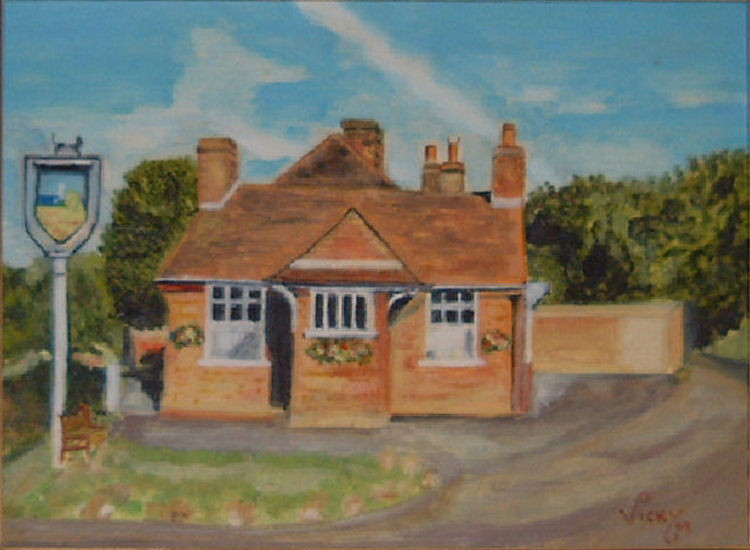
Above painting is of the Cat ad Custard Pot at Paddlesworth, by kind permission of
John Wiggins. |
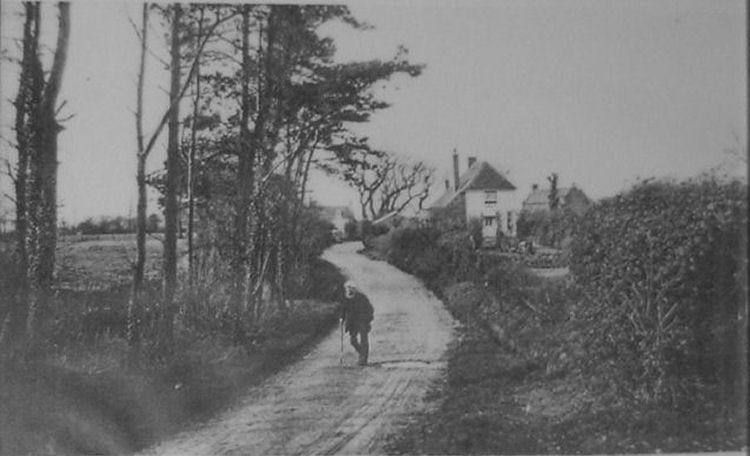
The Highest Church. The Lowest Steeple.
The Poorest Parish and the Fewest People.
|

Highest licensed house in Kent. 660 feet above sea level. Date
unknown. |
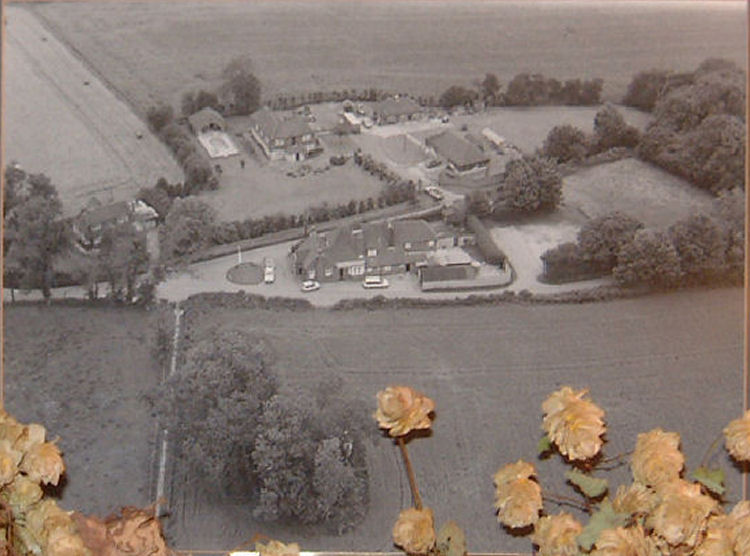
Birds-eye view of Cat and Custard Pot amongst the hops. Date unknown. |

Above photo, 25 July 1987, by Jim Ashby. |
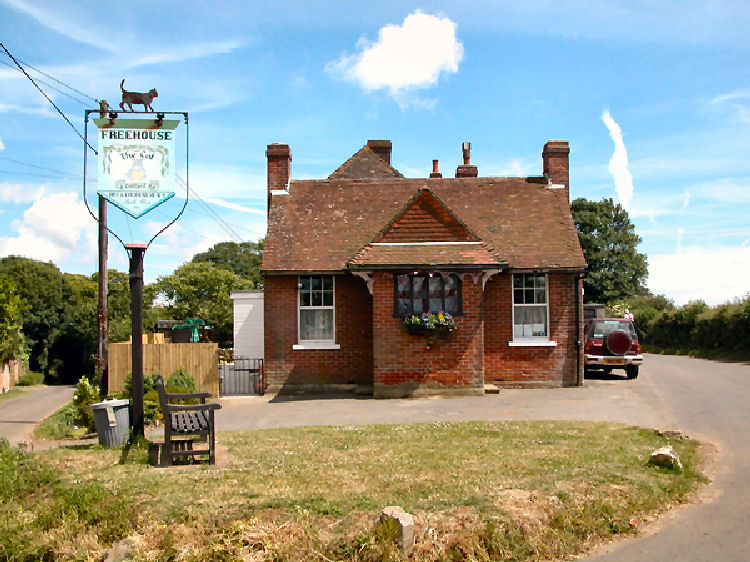
Cat & Custard Pot, 2004. |
 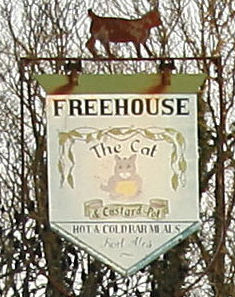
Above sign left, date unknown, sign right, December 2007, taken by Eric Hartland.
Sign left with thanks from Brian Curtis
www.innsignsociety.com. |
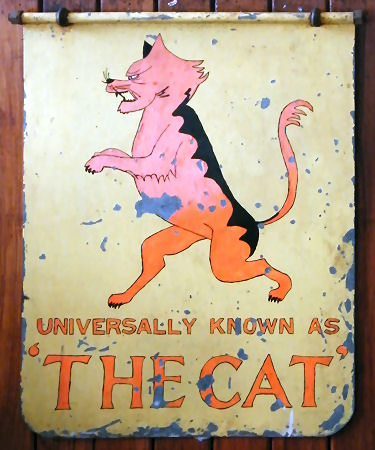 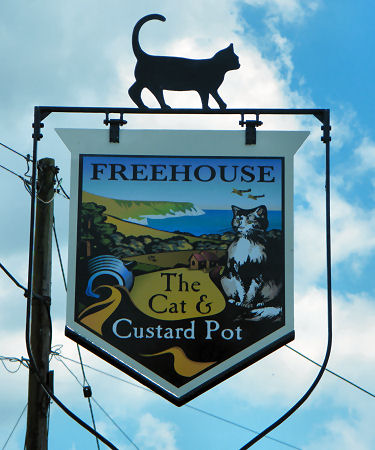
Above sign left, date unknown, sign right, June 2015. By Paul Skelton. |
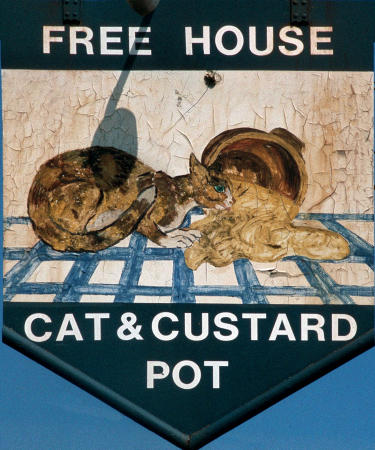
Above sign date unknown.
With thanks from Roger Pester
www.innsignsociety.com. |

Above sign, date unknown. |
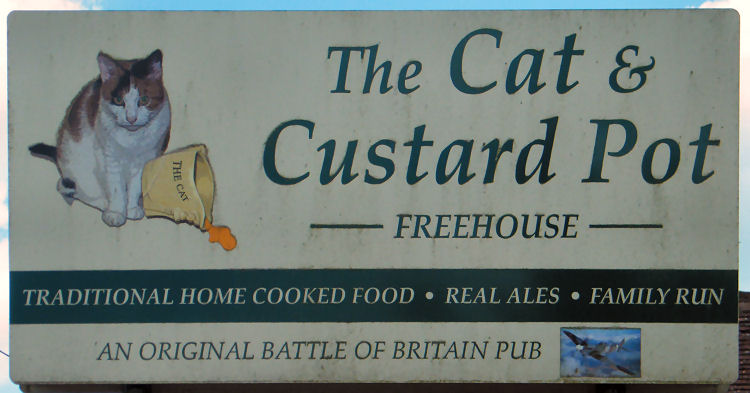
Above sign by Paul Skelton, 27 July 2015. |
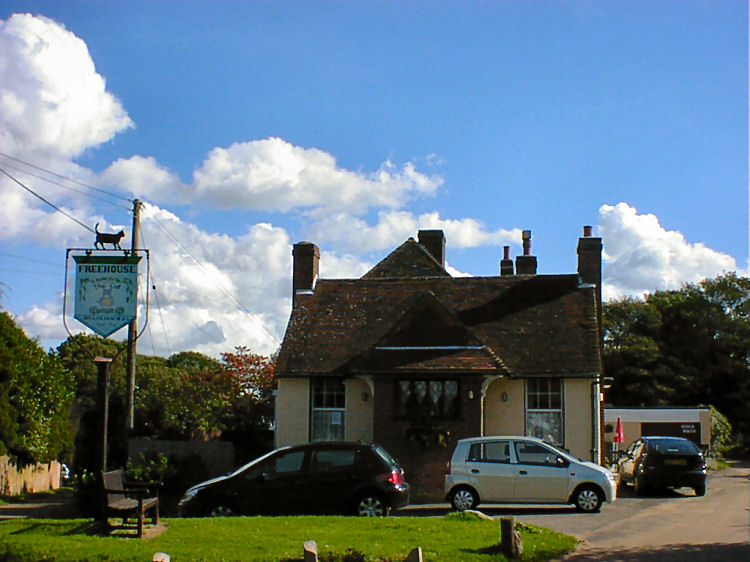
Cat and Custard Pot 2007. |
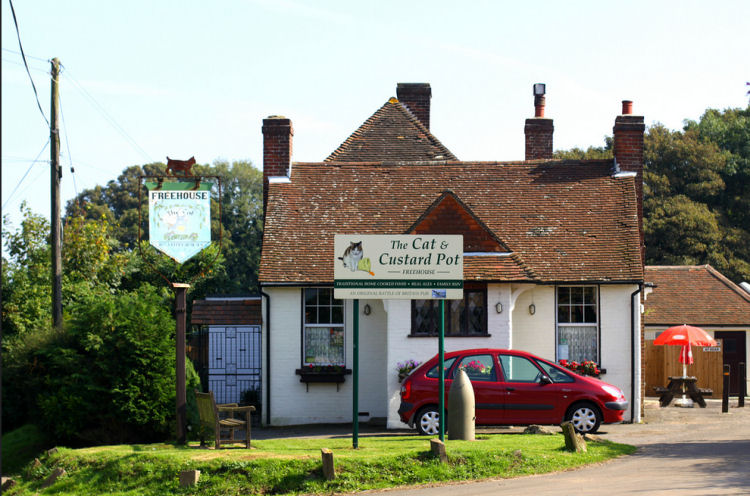 Photo taken
24 September 2013 from
http://www.flickr.com
by Jelltex. |
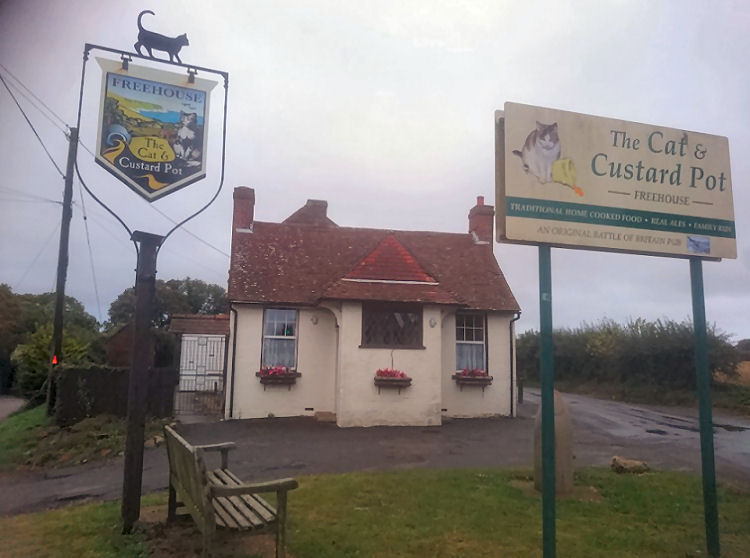
Above photo October 2019, kindly taken and sent by Rory Kehoe. |
This pub was once called the "Red
Lion Inn", but locally
it has been called "The Cat" for as far back as anyone can remember.
|
Dover Express, Friday 21 January 1910.
Hunting.
The East Kent Fox Hounds will meet at 11 on Wednesday, January 26th,
at the "Cat and Custard Pot Inn," Paddlesworth. |
This pub has been reported as being the highest pub in Kent and is
situated in the small hamlet of Paddlesworth near to Hawkinge.
This public house was used by
pilots and other personnel who were stationed at the nearby Hawkinge Battle
of Britain airfield.
Today the pub contains a varied collection of aviation
memorabilia and photographs that represent the history of the area during
the last 100 years.
I have heard two stories regarding how the pub gained its name of the
"Cat and Custard Pot". The beginnings of both stories are very similar. The
old sign for the "Red Lion" used to hang from a nearby tree and one day
after some fierce winds it was blown down and either lost or damaged. A new
board was commissioned and a local artist offered to take on the challenge.
This is where the stories differ slightly. According to their web site the
story goes:- "A new board was needed and the village artist obliged. The
new signboard was painted in gorgeous colours. The lion was depicted with
"fierce sprouting whiskers, his ears pricked and having boiling eyes." The
villagers assembled to gaze at the work of art and all declared that the
artist had not drawn a lion but a sprawling cat! Unfortunately the work of
art is untraceable." The other story I have heard is that the painting
was hung before the paint had dried properly, the artist had used Red Lead
paint for the bright red colours of the Lion, and this does tend to take a
little longer than ordinary paint to dry and of course is more prone to
gravity, being that it is a lot heavier than ordinary paint. On hanging, the paint ran causing the resulting picture to look like a local
ginger cat that had fallen into a custard pot.
Now, that isn't quite where the story ends, for, again quoted from their
web site:- "At one time the East Kent Foxhounds met at "The Cat and the
Mustard Pot", as it was called in the well known sporting volumes of
Yorricks. The explanation for the name "The Cat" we accept, but we find no
satisfactory origin for "The Cat and the Mustard Pot". We find this name in
newspapers at the turn of the century, yet later it became "The Cat and
Custard Pot." What was the reason? Just mispelling?" I do
however also hear that the pub was well-known for it's pork pies and beef
puddings, so perhaps that's where the name mustard comes in.
Who knows what the real story is? Unless someone out there can add any
more light to the above.
|
From an email received 18 July 2020.
During this current lock-down period I’ve spent some time researching pub signs &
and have thrown some light on the origin of the name for the above,
other explanations I’ve seen being a bit vague to put it mildly.
The Cat and Custard Pot (Red Lion) - Paddlesworth
In the 1830s author Robert Smith Surtees launched a new publication
called the 'New Sporting Magazine' targeting the exponents of country
sports. In it he included a series of fictional humourous short stories,
written by himself, featuring a John Bull type character named 'John
Jorrocks'. This man had a passion for country sports and hunting with
hounds, meeting at a fictional pub named The Cat and Custard Pot. The short
stories were published in book form under the title 'Jorrocks's Jaunts and
Jollities' in 1838 and became very popular, particularly with those like
minded participants.
The Red Lion used to be a meeting place for the East Kent Foxhounds where
people would gather and talk of every aspect of their favourite sport,
likening their meeting place to the fictional pub in the stories and
referring to it in a shortened way as The Cat. The nickname stuck and was
adopted by other locals and eventually used generally by all.
Later down the line someone involved in the brewing trade realised the
connection and the pub was renamed the "Cat and Custard Pot" in recognition
of Surtees's stories of John Jorrocks.
|
|
From RAMBLES AROUND FOLKESTONE BY "FELIX."
(1891-1913)
THE CAT AND MUSTARD POT."
In the printed list of appointments for the East Kent Foxhounds I
noticed recently that one of the meets was fixed to take place at "The
Cat and Mustard Pot," Paddlesworth.
Now this, the highest village in Kent, is a tiny community, and is
described in the ancient couplet as the "smallest parish."
Paddlesworth is remembered by many of us with feelings bordering on
affection, and so many rubbed their eyes to find that a new (hostelry
had been erected in this lofty position 650 feet above sea level. Some
people were heard to ask : "What about the "Red Lion?" or, as it is more
familiarly known, "The Cat" and "Sprawling Cat." I made a few enquiries,
and discovered that "The Cat and Mustard Pot" was one and the same
house.
"MUSTARD."
Why should this be associated with "The Cat ?" Our recollection goes
back to the time of the cricket week, to the time, top, of the "harvest
home" suppers, when the late Mrs. Dixon's famous beef puddings were
devoured with ease by the sons of the plough, and other farm hands.
In the years that are passed the skittle alley and a game called "jennypins"
figured largely. The ordinary townsman was no hand at this latter game,
and the ploughman would generally lead the way. What splendid times they
were, when a dozen young fellows would climb up the 650 feet from
Folkestone, say on some Saturday afternoon, to sit down later to a nice
supper. The appetites on those occasions were in good working order, and
no sauces were needed to kindle hunger. And later the piano would be
brought into requisition for the mirth and harmony. It was indeed
"mustard" to listen to some of those countrymen's songs, comprising
often forty verses or more.
Perhaps the memory of one of these vocalists would fail him, and then
some one would suggest that "Charley should go back forty verses." There
was a humour about it all. Yes, I contend that "mustard," if history
informs us rightly, was not inappropriately associated with "The Cat."
BUT WHY " THE CAT?"
Well, if truth be told, this was due to the village artist. The old
signboard hanging from the branch of the tree just outside of the hotel
was blown down once upon a time. That was when it was known to be the
"Red Lion." What was to be done? The village artist, who had earned a
certain fame, was equal to the occasion. He painted a new signboard in
gorgeous colours, and "the king of the forest" was depicted in
remarkable style. His fierce sprouting whiskers, his pricked up ears,
and bolting eyes rendered the representation of the lion as one of the
most remarkable on record. The villagers assembled to gaze on the
spectacle, and one and all declared that the artist had drawn, not a
lion, but a "sprawling cat." Hence the popular designation. And now,
after all these years we find that the real name is "The Cat and Mustard
Pot."
Mr. Selby-Lowndes, a true sportsman, appears to have known of the
title, for, as I have said, it is included in the hunting fixtures.
Perhaps some of my readers can explain matters. Since writing the above
I understand a reference to the "Cat and Mustard Pot" is made in the
well-known sporting volume of "Yorricks." And now, after writing all
this I hear the "Cat and Custard Pot" is the rightful designation.
However, "Mustard" fits in well.
|
|
Folkestone, Hythe, Sandgate & Cheriton Herald, Saturday 31 March 1923.
Cat and Custard Pot.
M.F. contribute to the way of "The Way of the World" column of the
"Morning Post" the following verses apropose of the fact at the East
Kent Foxhounds sometimes met at the "Cat and Custard Pot," Paddlesworth.
In all the countryside of Kent
Was ever a jollier spot
Than the inn that goes by the quaintest old name
Of the "Cat and Custard Pot?"
Tails are swag, and the Hunts away;
They move at a gentle trot-
A find - and the ringing hunt begins
From the "Cat and the Custard Pot."
A sporting line and a good stout fox,
And a capital hunt they got.
A six-mile point and they're all that way
From the "Cat and the Custard Pot."
So men of Kent, and ladies, too,
When the place is growing hot,
Remember how the day began
At the "Cat and the Custard Pot."
Another correspondent of the "Morning Post" has since written:- M.F.'s
lively lines on hounds meeting at the "Cat and Custard Pot Inn" reminds
me that the the appellation is a nickname given by local people to the
"Red Lion" at Paddlesworth. "Cat" names of public houses are often
interesting to antiquarians and etymologists. Thus the "Cat and
Bagpipe's" of East Harley is said to be a humourous hit at the Highland
drovers who passed that way with cattle for London. And the "Cat and
Fiddle" at Hinton Admiral, which recalls the famous nursery rhyme is to
perpetuate a corruption of Caton le Fiddle, whoever he may have been. To
me such derivations seem too clever and far-fetched, and perhaps some of
your readers can correct them.
|
|
Folkestone, Hythe, Sandgate & Cheriton Herald. Saturday 15 September 1934.
"Red Lion," "Sprawling Cat," "Ramping Cat," or "Cat and Custard Pot."
There have been from time to time many stories current with regard to
the descriptive designation of the one in that served the needs of the
few inhabitants of the Hamlet. I don't know how it came about that the
irreverent came to call this inn by anything but it's first title,
namely, the "Red Lion." But I do know that at one time sign board swung
from one of the branches of a tree outside the establishment. Right
enough the "King of the Forest," with a real mane, was well depicted on
the board.
One night a gale from the southwest blew with such terrible force that
the board crashed to the ground in pieces. Here was a "pretty to do." A
new board had to be ordered at once. The landlord of many years ago was
about to give commission to a Folkestone decorative artist to paint a
new board, but the whole village was against this. They argued, why not
give the job to "Old Jarge" the ploughman. He can draw, they argued, and
"Jarge" got the job.
What is the strange animal?
In his little spare time "Old Jarge" started on his work. In the matter
of colourings (paints) he had secured all the shades of the rainbow.
When the village artist had completed his work the rustics and mandarins
of the village gathered round to inspect the new sign board on which was
represented the "King of the Forest."
Some would have it that "Old Jarge" had produced a cross between a
Bengal tiger and an African lion. I recall it was a curious looking
animal, with bolting eyes, long sprouting whiskers, and a generally
fierce appearance.
The sign hung over the neighbouring roadway, and it is said that many a
huntsman's mount bolted when it gazed on Old Jarges" work. Visitors and
residents were wont to travel up to Paddlesworth in order to decide
whether the animal depicted was a lion, tiger, wildcat, or a mixture of
all.
The splendid sportsman, the late Mr. H. Selby Lowndes, got so "fed up"
with the discussion that he designated the inn as "The Cat and Custard
Pot." Whether that appears in the pages of "Jorrocks" it is not for me
to say. However it never was decided whether "Old Jarge's" painted
animal was a crossbred specimen or not.
|
|
From KentNews.co.uk 2 Oct 2010.
SPOOF VILLAGE NEWSPAPER REALLY IS THE END OF THE
WORLD.
By STEVE KNIGHT
NAME GAME:
The website's fictional town has the same name as the
Folkestone village.
"COUNCIL Killjoys: No More Cat Throwing" screams the headline from one
of the many bizarre stories featured on the new Paddlesworth Press
website.
When it comes to blurring fact with fiction, there are few more baffling
ventures out there than this online newspaper spoof inspired by two very
real Kentish locations.
Although the website has shamelessly stolen certain elements of the
real-life Paddlesworth, near Folkestone - including village pub the "Cat
and Custard Pot" - the make-believe community is based in the
also-factual lost settlement of Paddles worth, in Snodland, near
Maidstone.
And to make things even more confusing, many of the characters featured
in the stories have Facebook, Twitter or MySpace accounts which are
regularly updated to keep the charade going.
Former Cambridge University student Stephen Eisenhammer, 23, is one of
the cocreators of the website, which he describes as "the world's first
mixed-media, collaborative novel".
He added: "We thought it would be exciting to let readers influence what
happens in Paddlesworth. We only launched the site
this week, but within a day we had people posting comments and claiming
to be characters from our community, playing along and asking the editor
to launch a campaign to save the cat-throwing tradition.
"What really thrilled us was the way we could lose the boundaries
between us and the readers, because we felt there was a slight
pointlessness in writing satirical papers without that interaction."
Economic climate
In addition to the news stories, blogs and sports profiles included on
the Paddlesworth Press website, there are other familiar newspaper
sections such as horoscopes and letters.
The website is only planning to run for the next 10 weeks, as one of the
main stories featured reveals the Earth will be wiped out at that point
by an errant solar flare.
Mr Eisenhammer revealed that about 50 people work on the site, including
television
stand-up comedian Jack Whitehall.
He added: "It's a reflection of the current economic climate because if
we all had really good jobs then we wouldn't need to do it.
"We all remember the excitement of writing plays and editing newspapers
at university, but now we've graduated to find there are no
opportunities to do what we know we are good at.
"People were so keen to get involved with the project because it's so
nice to have a forum on which to demonstrate your creativity."
Mr Eisenhammer revealed that although the fictional village of
Paddlesworth has a Medway postcode, he has no idea where any parcels or
letters sent to it will end up.
He also admitted he had not considered how those people living in the
real-life community near Folkestone might feel about the light-hearted
identity theft.
"I'm sure they'll see the funny side," he said.
|
|
From the spoof online newspaper Paddlesworth Press. 2 Oct 2010.
PADDLESWORTH'S COUPLE OF THE WEEK.
Love is in the air! Mr Ed Tomlinson and Miss Emily Gena are loved up and
getting married. They met after Ed spied Emily's plea for a philosophy
loving energetic male, published in Lovelight last summer. He took her
for a picnic at the stone circle, where they drank wine and had a cheeky
fumble… the rest is history! ‘I have struck on the perfect country
bumpkin' says Emily, ‘he spices his home-grown vegetable soups with a
dose of Plato Talk'. Awww, inspired and in love the soon to be
Tomlinsons are a triumph of the Paddlesworth lurve scene. Celebratory
engagement drinks will be held at the "Cat and Custard" next Wednesday.
|
|
From the spoof online newspaper "Paddlesworth Press".
2 October 2010
FETE DESTINED TO BE BEST EVER.
Oliver Reed
This year's fete is set to be the best in years. The village has
responded to Monday's terrible news determined to make Saturday's event
"the fete to end all fetes".
Mary Burgess, this year's chief organiser, has been working round the
clock but is delighted with the village support she has received. "I had
been worried Monday's exclusive would put a dampener on proceedings but
everyone has been fantastic. We all want to make Saturday perfect", she
told the Paddle.
In the midst of Snodland Council's decision to ban Cat Throwing, Jimmy
Crowhurst has proposed hiding the cats in wellies. This has been met
with general accord. The proposal, which both protects and removes the
cats from public view, bypasses new legislation which states, "Felines
may not be openly thrown in public competition".
However, Mark Upton, village PC will be on hand to check that everything
goes smoothly so villagers will have to be on their guard that no cats
crawl out of their projectile rubber homes.
This year's Cat Throwing competition is predicted to be the closest in
over a decade. Peter Muddle is attempting to become the first ever
Paddlesworthian to win the event four years running. He is currently
tied with the legendary village athlete, Cuthbert Howard (the Major's
grandfather).
However, rival Jimmy Crowhurst has sworn to stop Muddle from getting his
name in the history books. Last year's silver medallist has made no
secret of his hatred of Muddle and the two reportedly had a minor clash
outside the Cat and Custard Pot free house yesterday evening.
Crowhurst has been in fine form, but is known to struggle in big game
situations. There's no bigger stage than the annual fete, so it remains
to be seen if Crowhurst can hold his nerve. If he can it would go down
as one of the greatest sporting upsets the village has ever seen.
The award for the best marrow will also be awarded this Saturday and
many are tipping Farmer Joe Smitten to take the crown. Smitten who has
been embroiled in scandal over the death of cellist Henry Joy, killed by
a hay bale from one of Smitten's fields, is looking for redemption. "I
just want to put that terrible accident behind me". However, villagers
who have boycotted milk from Smitten's Landlowes farm in since the
tragedy have shown little sign of backing down despite the critical milk
shortage.
All in all it looks set to be a very exciting Saturday.
|
|
From YourDover 20 Oct 2010.
Familiarity breeds comic possibilities in 'virtual'
village
By STEVE KNIGHT
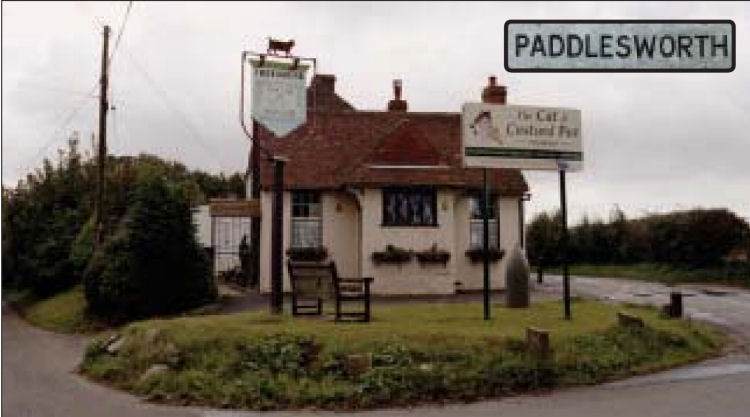
"COUNCIL Killjoys: No More Cat Throwing" screams the headline from one
of the many bizarre stories featured on the new Paddlesworth Press
website.
When it comes to blurring fact with fiction, there are few more
baffling ventures out there than this online newspaper spoof inspired by
two very real Kent locations.
Although the website has shamelessly
stolen certain elements of the real-life Paddlesworth, near Folkestone -
including village pub The Cat And Custard Pot - the make-believe
community is based in the also-factual lost settlement of Paddlesworth,
in Snodland. And to make things even more confusing, many of the
characters featured in the stories have Facebook, Twitter or MySpace
accounts which are updated regularly to keep the charade going.
Former
Cambridge University student Stephen Eisenhammer, 23, is one of the
creators of the website, which he describes as "the world's first
mixed-media,
collaborative novel".
He said: "We thought it would be exciting to let readers influence what
happens in Paddlesworth.
"Within a day [of starting the site] we had
people posting comments and claiming to be characters from our
community, playing along and asking the editor to launch a campaign to
save the cat-throwing tradition.
"What really thrilled us was the way we
could lose the boundaries between us and the readers, because we felt
there was a slight pointlessness in writing satirical papers without
that interaction."
In addition to the numerous news stories,
blogs and sports profiles included on the Paddlesworth Press website,
there are also other familiar newspaper sections including horoscopes
and letters.
The website is only planning to run for 10 weeks, as one of
the main stories featured leaked to reporters by a rogue astrophysicist
- reveals that Earth will be wiped out at that point by an errant solar
flare.
Mr Eisenhammer revealed that about 50 people work on the site,
including television stand-up comedian Jack Whitehall.
He said: "It's a
reflection of the current economic climate because if we all had really
good jobs then we wouldn't need to do it.
"We all remember the
excitement of writing plays and editing newspapers at university, but
now we've graduated to find there are no opportunities to do what we
know we are good at.
"People were so keen to get involved with the
project because it's so nice to have a forum on which to demonstrate
your creativity."
Mr Eisenhammer revealed that although the fictional
village of Paddlesworth has a Medway postcode, he has no idea where any
parcels or letters sent to it will end up.
He also admitted he had not
considered how those people living in the real-life community near
Folkestone might feel about the light-hearted identity theft.
"I hope they're not upset," he said. "I can imagine it would be very
odd to read about certain parts of their village on our website, but
it's a very small place so I'm sure they'll see the funny side."
|
LICENSEE LIST
WIGGINS Peter 1975-95
WIGGING Jeane and John (Son) 1995 current date.
 From
the Kelly's Directory 1934 From
the Kelly's Directory 1934
|
















